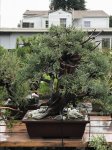chicago1980
Omono
- Messages
- 1,426
- Reaction score
- 2,731
Hello Michael.I just noticed this thread. Forgive Scott me but I must say I'm disappointed. Too me it has been tamed and civilized into another Japanese garden tree. There is a massive problem (as I see it) developing when we entrust these wild trees into the hands of modern Japanese-trained professionals who are completely out of original ideas. I think this tree should have been sat on for another few years and properly studied for the possibilities. As an example, were is the logic in bringing down the branches when the history of the tree (the old jins) are growing up? In my opinion, this reduces the authenticity of the final image. I hope I'm not too out of line in saying this Scott but that is the first thing I thought when I saw the last pic. Either way, it will of course be a high quality tree in anyone's eyes.
I have seen you post a few times about an interesting idea of originality in Bonsai. I am rather new to this form of art and hoping you could share photos of your trees. As I often see the Japanese form of Bonsai and would appreciate the visual input. Thank you.

